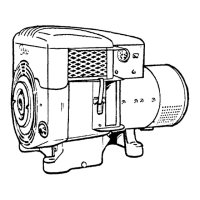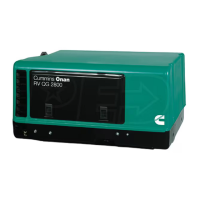VENTILATION
AND
ACOUSTICS
The most important factors of ventilation for an air-
cooled JW electric generating set are sufficient in-
coming'cooling airand exhausting heated air. Before
considering the installation problems, knowledge of
how an Onan unit cools itself is needed. See Figure 4.
WARNING
Never use discharged cooling air for heating
since it can contain poisonous gases.
FIGURE 5. RADIATOR AIR REQUIREMENTS
FIGURE 4. TYPICAL ONAN RV COOLING SYSTEM
AIR
REQUIREMENTS
The 12.0 RDJC running at 1800 rpm requires a
min-
imum radiator air inlet opening 17.5" wide x 17.75"
high with no restrictions. The cooling air through the
floordischargeductis 160cubicfeet perminute. See
Figure 4 and 5.
WARNING
Insulation must not reduce the minimum
clearances as specified In Figure
2,
to comply
with temperature rise and safety requirements of recreational
veh-
icles,
to prevent fire hazard.
RESTRICTED
AIR
OPENINGS
Sheet metal with louvers can be used over inlet areas.
However, some provide only 60 percent free inlet area
per square foot. Even the most efficient grille only
provides about 90 percent free inlet area per square
foot. The free inlet area of the material can be
obtained from the manufacturer. Unrestricted air
inlet requirements for this set is 264 square inches
(1.8 square feet). See Figure 5.
COMPARTMENT
ACOUSTICAL
LINING
1.
Be sure all joints and corners of the compartment
are vapor tight to coach interior before lining with
acoustical material.
Lining the compartment does little if opening,
cracks, door and joints are not sealed. Also make
sure compartment door edge is sealed to elimi-
nate noise-air leaks around the door perimeter.
2.
Cover the sound reflective surfaces, back, top
and sides (not compartment base) with fiberflass
or other noncombustible acoustical material. It
should be no less than one inch thick and approx-
imately two pounds persquarefoot in density. Be
sure adhesive used is also noncombustible. Test
acoustical material and adhesive for heat effects
before using.
3. Rather than using one single material of two
pound per square foot density, a combination of
materials can reduce noise even more. For exam-
ple,
a sheet of lead or visoelastic material of one-
half to one pound per square foot density and a
layer of one inch acoustical material of two pound
per square foot density, respectively, is far more
superior.
WARNING
Separate installation area or compart-
ment from living quarters by a vapor-
tight wall to prevent entrance of noxious fumes to interior and
possible asphyxiation hazard.
WARNING
Insulation must not reduce the
min-
imum clearances as specified in Figure 2
to comply with temperature rise and safety requirements for
recreational vehicles to prevent fire hazard.

